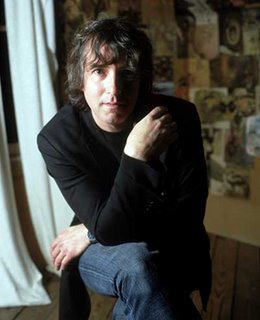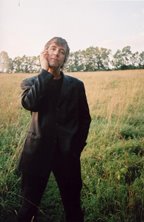Reinventing the Blues
Former Swans drummer Jonathan Kane hits the blue note with measured minimalism
 When Jonathan Kane takes his place behind the drums at Eyedrum on Monday, March 20th it will be his first performance in Atlanta in nearly 23 years. In May of 1983 Kane thundered through town with the New York proto-industrial outfit, Swans opening for Sonic Youth on what was lovingly called the “Savage Blunder Tour.” It was the first time either of the seminal NYC noise rockers had taken their shows on the road. Each night both bands were greeted with scowling bewilderment from the audience. The Atlanta gig at The 688 Club was no different as the group unleashed it’s alienating and gut-punching pummel onto the South.
When Jonathan Kane takes his place behind the drums at Eyedrum on Monday, March 20th it will be his first performance in Atlanta in nearly 23 years. In May of 1983 Kane thundered through town with the New York proto-industrial outfit, Swans opening for Sonic Youth on what was lovingly called the “Savage Blunder Tour.” It was the first time either of the seminal NYC noise rockers had taken their shows on the road. Each night both bands were greeted with scowling bewilderment from the audience. The Atlanta gig at The 688 Club was no different as the group unleashed it’s alienating and gut-punching pummel onto the South.
For Kane a lot has changed over the last two-and-a-half decades. Rather than bashing out plodding, industrial rhythms, these days he plays the blues. But don’t expect to catch him jamming on gentrified covers of “Mustang Sally,” Kane’s sound is a blasting, instrumental blues-drone dirge that balances the music’s natural sense of minimalism with working man’s grit and an avant-garde shimmer.
 The swirling, road house rhythms on his debut EP, February (Table of the Elements) are a far cry from Swans’ crushing industrial racket. But Kane maintains that despite the aesthetic differences between Swans’ skulk and his own blustery blues inventions, the more things change, the more they stay the same.
The swirling, road house rhythms on his debut EP, February (Table of the Elements) are a far cry from Swans’ crushing industrial racket. But Kane maintains that despite the aesthetic differences between Swans’ skulk and his own blustery blues inventions, the more things change, the more they stay the same.
“My first passion in music has always been the blues,” Kane says. “It’s where I cut my teeth.”
After spending his teenager years in Woodstock, NY drumming for the Kane Bros. Blues Band – alongside his brother Anthony on vocals and harmonica – Kane sharpened his teeth at Berkley Music College in Boston.
Soon after, he returned to New York and joined forces with vocalist/guitarist Michael Gira. The two first convened as Circus Mort, but on the eve of releasing their first record, the group broke up. That same night Gira invited Kane to join a new group he was putting together, called Swans.
“I was still thinking about the blues in one way or another,” Kane adds. “When I hooked up with Michael I still had that sense of time and rhythm in my mind -- even while I was pounding away on Swans’ songs.” he continues. “We would trade records: He would give me a Wire record and I would give him Howlin’ Wolf. It was between these various influences that we forged Swans.”
Kane didn’t stick around with Swans for too much longer. Only a few obscure, early releases, including the group’s first full-length, Filth bare Kane’s name, but he left an indelible mark on Swans’ sound. His propensity for slowing down tempos created the creeping, dirge-like pace that became the group’s signature which lasted long after Kane’s departure.
“Blues time and playing a song that was intense but also slow was important in developing those rhythms that were a slow, crawling thing,” Kane explains. “After I left the group they were still known for that slow sound and I have to claim a large amount of credit for that.”
After leaving Swans Kane continued working in downtown New York art rock circles. His most notable forays include drumming in Rhys Chatham’s 100 Guitar Orchestra, and providing the infinite beat behind minimalism godfather La Monte Young in the Forever Bad Blues Band.
A performance by the Forever Bad Blues Band consists of anywhere from 1-3 hours of the group locking into a dirty, atonal blues riffs with minimal chord progressions. Kane’s time spent with Young no doubt informed his more recent work but the seed of minimalism hiding inside the dank and distorted cadences of the blues has always piqued Kane’s ears.
Like Latin, blues music posses all of the qualities of a dead language. Any major developments in the genre are few and very far between. But despite its cultural stagnancy, Kane sees it as a vital art form bound for a renaissance. “Blues is at the core of all American popular music, but the last major development was in the ’50s when Muddy Waters and Howlin’ Wolf plugged-in to amplifiers,” Kane declares. “Everything in its wake has referenced that. Nonetheless it’s a timeless form because it’s about human feeling and emotion first. It’s only a matter of time before someone comes up with a new way to approach it,” he continues. “One thing I had thought about for a long time before working with La Monte was that the blues is an inherently minimalist art form. At its most complex it’s three chords. At its very least it’s one chord, and that’s minimalism in a nut shell.”
 Throughout February, monstrous rhythms in “Curl” and the circular motion of “Pops” build tension with subtly shifting parts shrouded in voluptuous grooves. “Motherless Child” is a traditional number that unfolds with Morricone-esque majesty and a rework of Chatham’s “Guitar Trio” injects a swinging blue note into the pendulous plod of Chatham’s stark arrangmenets.
Throughout February, monstrous rhythms in “Curl” and the circular motion of “Pops” build tension with subtly shifting parts shrouded in voluptuous grooves. “Motherless Child” is a traditional number that unfolds with Morricone-esque majesty and a rework of Chatham’s “Guitar Trio” injects a swinging blue note into the pendulous plod of Chatham’s stark arrangmenets.
Live these songs take on an even larger presence. Kane has assembled a six-piece band, dubbed Jonathan Kane’s February which features Modern Lovers founding member, Ernie Brooks playing bass. Four guitarists also supplement the line-up, including David Daniell (San Agustin), Igor Cubrilovic and David Bicknell and Jon Crider of NYC experimental rock act, Clara Venus.
Just as Kane’s show sidesteps the trappings of bar band blues rock, it also transcends the stuffy, art gallery nature of minimalism while forging both influences into rollicking and cerebral groove-driven nods. “Something that makes you think and makes your pelvis move is the ultimate experience,” Kane adds without a hint of irony. “We played Tonic in Manhattan the other night and people actually danced,” he laughs. “You don’t see that at a minimalist concert. I’ve played Tonic a million times with other people and I never had people out there get up and start shaking their butts.”
Story By Chard Radford. Top photo by Bridget Barrett. Bottom photo by Holly Anderson. Published by Creative Loafing, Atlanta (March 6, 2006).
 When Jonathan Kane takes his place behind the drums at Eyedrum on Monday, March 20th it will be his first performance in Atlanta in nearly 23 years. In May of 1983 Kane thundered through town with the New York proto-industrial outfit, Swans opening for Sonic Youth on what was lovingly called the “Savage Blunder Tour.” It was the first time either of the seminal NYC noise rockers had taken their shows on the road. Each night both bands were greeted with scowling bewilderment from the audience. The Atlanta gig at The 688 Club was no different as the group unleashed it’s alienating and gut-punching pummel onto the South.
When Jonathan Kane takes his place behind the drums at Eyedrum on Monday, March 20th it will be his first performance in Atlanta in nearly 23 years. In May of 1983 Kane thundered through town with the New York proto-industrial outfit, Swans opening for Sonic Youth on what was lovingly called the “Savage Blunder Tour.” It was the first time either of the seminal NYC noise rockers had taken their shows on the road. Each night both bands were greeted with scowling bewilderment from the audience. The Atlanta gig at The 688 Club was no different as the group unleashed it’s alienating and gut-punching pummel onto the South.For Kane a lot has changed over the last two-and-a-half decades. Rather than bashing out plodding, industrial rhythms, these days he plays the blues. But don’t expect to catch him jamming on gentrified covers of “Mustang Sally,” Kane’s sound is a blasting, instrumental blues-drone dirge that balances the music’s natural sense of minimalism with working man’s grit and an avant-garde shimmer.
 The swirling, road house rhythms on his debut EP, February (Table of the Elements) are a far cry from Swans’ crushing industrial racket. But Kane maintains that despite the aesthetic differences between Swans’ skulk and his own blustery blues inventions, the more things change, the more they stay the same.
The swirling, road house rhythms on his debut EP, February (Table of the Elements) are a far cry from Swans’ crushing industrial racket. But Kane maintains that despite the aesthetic differences between Swans’ skulk and his own blustery blues inventions, the more things change, the more they stay the same.“My first passion in music has always been the blues,” Kane says. “It’s where I cut my teeth.”
After spending his teenager years in Woodstock, NY drumming for the Kane Bros. Blues Band – alongside his brother Anthony on vocals and harmonica – Kane sharpened his teeth at Berkley Music College in Boston.
Soon after, he returned to New York and joined forces with vocalist/guitarist Michael Gira. The two first convened as Circus Mort, but on the eve of releasing their first record, the group broke up. That same night Gira invited Kane to join a new group he was putting together, called Swans.
“I was still thinking about the blues in one way or another,” Kane adds. “When I hooked up with Michael I still had that sense of time and rhythm in my mind -- even while I was pounding away on Swans’ songs.” he continues. “We would trade records: He would give me a Wire record and I would give him Howlin’ Wolf. It was between these various influences that we forged Swans.”
Kane didn’t stick around with Swans for too much longer. Only a few obscure, early releases, including the group’s first full-length, Filth bare Kane’s name, but he left an indelible mark on Swans’ sound. His propensity for slowing down tempos created the creeping, dirge-like pace that became the group’s signature which lasted long after Kane’s departure.
“Blues time and playing a song that was intense but also slow was important in developing those rhythms that were a slow, crawling thing,” Kane explains. “After I left the group they were still known for that slow sound and I have to claim a large amount of credit for that.”
After leaving Swans Kane continued working in downtown New York art rock circles. His most notable forays include drumming in Rhys Chatham’s 100 Guitar Orchestra, and providing the infinite beat behind minimalism godfather La Monte Young in the Forever Bad Blues Band.
A performance by the Forever Bad Blues Band consists of anywhere from 1-3 hours of the group locking into a dirty, atonal blues riffs with minimal chord progressions. Kane’s time spent with Young no doubt informed his more recent work but the seed of minimalism hiding inside the dank and distorted cadences of the blues has always piqued Kane’s ears.
Like Latin, blues music posses all of the qualities of a dead language. Any major developments in the genre are few and very far between. But despite its cultural stagnancy, Kane sees it as a vital art form bound for a renaissance. “Blues is at the core of all American popular music, but the last major development was in the ’50s when Muddy Waters and Howlin’ Wolf plugged-in to amplifiers,” Kane declares. “Everything in its wake has referenced that. Nonetheless it’s a timeless form because it’s about human feeling and emotion first. It’s only a matter of time before someone comes up with a new way to approach it,” he continues. “One thing I had thought about for a long time before working with La Monte was that the blues is an inherently minimalist art form. At its most complex it’s three chords. At its very least it’s one chord, and that’s minimalism in a nut shell.”
 Throughout February, monstrous rhythms in “Curl” and the circular motion of “Pops” build tension with subtly shifting parts shrouded in voluptuous grooves. “Motherless Child” is a traditional number that unfolds with Morricone-esque majesty and a rework of Chatham’s “Guitar Trio” injects a swinging blue note into the pendulous plod of Chatham’s stark arrangmenets.
Throughout February, monstrous rhythms in “Curl” and the circular motion of “Pops” build tension with subtly shifting parts shrouded in voluptuous grooves. “Motherless Child” is a traditional number that unfolds with Morricone-esque majesty and a rework of Chatham’s “Guitar Trio” injects a swinging blue note into the pendulous plod of Chatham’s stark arrangmenets.Live these songs take on an even larger presence. Kane has assembled a six-piece band, dubbed Jonathan Kane’s February which features Modern Lovers founding member, Ernie Brooks playing bass. Four guitarists also supplement the line-up, including David Daniell (San Agustin), Igor Cubrilovic and David Bicknell and Jon Crider of NYC experimental rock act, Clara Venus.
Just as Kane’s show sidesteps the trappings of bar band blues rock, it also transcends the stuffy, art gallery nature of minimalism while forging both influences into rollicking and cerebral groove-driven nods. “Something that makes you think and makes your pelvis move is the ultimate experience,” Kane adds without a hint of irony. “We played Tonic in Manhattan the other night and people actually danced,” he laughs. “You don’t see that at a minimalist concert. I’ve played Tonic a million times with other people and I never had people out there get up and start shaking their butts.”
Story By Chard Radford. Top photo by Bridget Barrett. Bottom photo by Holly Anderson. Published by Creative Loafing, Atlanta (March 6, 2006).


<< Home